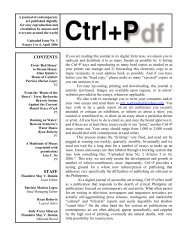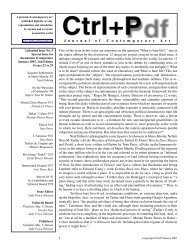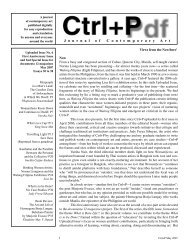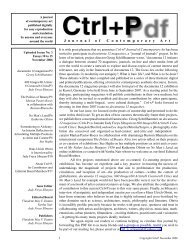Issue 15 - Pdf Ctrl+P - CTRL+P: a journal of contemporary art
Issue 15 - Pdf Ctrl+P - CTRL+P: a journal of contemporary art
Issue 15 - Pdf Ctrl+P - CTRL+P: a journal of contemporary art
You also want an ePaper? Increase the reach of your titles
YUMPU automatically turns print PDFs into web optimized ePapers that Google loves.
patrick d. flores<br />
Object Lessons from Gwangju<br />
It was late December in 2007 when I got an email from Okwui Enwezor inviting me to be<br />
p<strong>art</strong> <strong>of</strong> a section <strong>of</strong> the 7th Gwangju Biennale he was directing with two curators in the<br />
year that was to commence. I knew <strong>of</strong> Okwui through his work in criticism, theory, and<br />
exhibition making, and I found his disposition toward curation uniquely sharp, responsive,<br />
and venturesome. The opportunity to work with him was an important moment in my<br />
own efforts in the field, and to renew ties with one <strong>of</strong> the curators, the Indian poet and<br />
critic Ranjit Hoskote, with whom I had worked in the past in exhibitions, conferences,<br />
and publications, was something not to be missed.<br />
The invitation also came at a time when friend and colleague Joselina Cruz was<br />
appointed as one <strong>of</strong> the curators <strong>of</strong> the 2nd Singapore Biennale, which was to open days<br />
away from Gwangju in 2008. Yeyey, as the local <strong>art</strong> world calls her, is the first Philippine<br />
curator to be p<strong>art</strong> <strong>of</strong> a curatorium <strong>of</strong> an exhibition <strong>of</strong> the biennale mode. I thought that<br />
these appointments were carving out vital space for curators in the country: here, they<br />
could practice within a wider ambit and in conversation with denser layers <strong>of</strong> curatorial<br />
and <strong>art</strong>istic issues.<br />
Also, the Gwangju episode allowed me to pursue other trajectories <strong>of</strong> curation.<br />
I had previous experience with slightly different structures <strong>of</strong> international curation. For<br />
the Third Asia-Pacific Triennial in Brisbane, Australia in 1999, I was a co-curator for<br />
the Philippines with the Australian <strong>art</strong>ist and critic Pat H<strong>of</strong>fie. In the same year, I was<br />
the curator <strong>of</strong> the Philippine Pavilion at the First Melbourne Biennale. And from 2000 to<br />
2003, I worked with eight curators from seven Asian countries for the Under Construction:<br />
New Dimensions in Asian Art project under the auspices <strong>of</strong> the Japan Foundation.<br />
In these forays, the focus was either representation <strong>of</strong> an <strong>art</strong> world or exploration <strong>of</strong><br />
energy <strong>of</strong> <strong>contemporary</strong> <strong>art</strong>. But for Gwangju, I had more latitude to link up my research<br />
in curation in Southeast Asia, my theoretical reflections on <strong>contemporary</strong> <strong>art</strong>, and the<br />
actual practice <strong>of</strong> curation within a biennale context under the directorship <strong>of</strong> a wellknown<br />
curator from Nigeria based in the United States. Clearly, there was a discernible<br />
post-colonial critique in this sortie, but one that would be inflected with a reconsideration<br />
<strong>of</strong> radical political strategy or democratic discourse evoked by the site itself, Gwangju,<br />
in which an uprising in May 1980 helped topple a tenacious dictatorship and sparked<br />
the minjung movement. The specter <strong>of</strong> the minjung would be raised by Okwui as a foil<br />
to the privileged totem <strong>of</strong> rupture in Europe, the May 1968 student protest and strike in<br />
France. These historical coordinates are salient in trying to understand the foundations<br />
<strong>of</strong> <strong>contemporary</strong> <strong>art</strong> or any other critical modernities that p<strong>art</strong>ly arose from resistance<br />
to authority, norm, establishment, and master narrative. That Okwui was insistent on<br />
this thoroughgoing theoretical discussion (workshops, seminars, and a thick catalogue)<br />
invested the biennale with a robust theoretical framework, a commitment that was quite<br />
absent in the other eight biennales that opened in the same season <strong>of</strong> the year in Asia.<br />
This was an unprecedented ascendancy <strong>of</strong> exhibition making in the region, prompting<br />
some observers to herald an Asian century.<br />
The section for which I was asked to contribute was called Position Papers,<br />
which was a series <strong>of</strong> five small-scale curatorial projects initiated by five curators with<br />
divergent persuasions, from the enigmatic to the carnivalesque. We were given a free hand<br />
to propose anything; and this liberty was key to conceiving unpredictable, uneven, and<br />
idiosyncratic platforms. The section was meant to create another level to the biennale,<br />
which consisted <strong>of</strong> an anthology <strong>of</strong> the previous year’s exhibitions and commissions for<br />
specific sites in Gwangju. Our section had a more vertical orientation as it tried to probe<br />
certain impulses in <strong>contemporary</strong> <strong>art</strong> without regard for the new and the now.<br />
I proposed Turns in Tropics: Artist-Curator, a discussion <strong>of</strong> the practice <strong>of</strong> four<br />
germinal figures in Southeast Asia who st<strong>art</strong>ed out as <strong>art</strong>ists <strong>of</strong> an avant garde inclination<br />
and then became pioneering independent curators in their respective <strong>art</strong> worlds: Jim<br />
Supangkat <strong>of</strong> Indonesia, Apinan Poshyananda <strong>of</strong> Thailand, Redza Piyadasa <strong>of</strong> Malaysia,<br />
20 <strong>Ctrl+P</strong> September 2009







